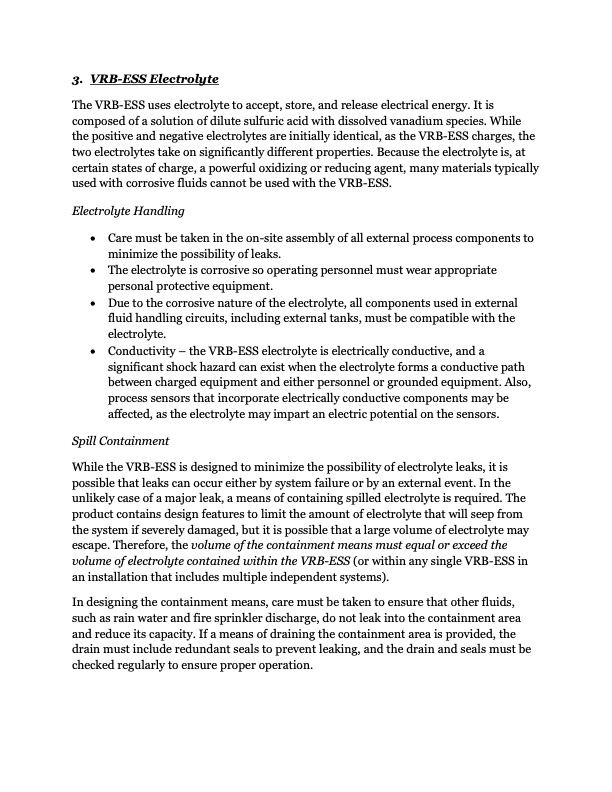
PDF Publication Title:
Text from PDF Page: 048
3. VRB-ESSElectrolyte The VRB-ESS uses electrolyte to accept, store, and release electrical energy. It is composed of a solution of dilute sulfuric acid with dissolved vanadium species. While the positive and negative electrolytes are initially identical, as the VRB-ESS charges, the two electrolytes take on significantly different properties. Because the electrolyte is, at certain states of charge, a powerful oxidizing or reducing agent, many materials typically used with corrosive fluids cannot be used with the VRB-ESS. Electrolyte Handling • Care must be taken in the on-site assembly of all external process components to minimize the possibility of leaks. • The electrolyte is corrosive so operating personnel must wear appropriate personal protective equipment. • Due to the corrosive nature of the electrolyte, all components used in external fluid handling circuits, including external tanks, must be compatible with the electrolyte. • Conductivity – the VRB-ESS electrolyte is electrically conductive, and a significant shock hazard can exist when the electrolyte forms a conductive path between charged equipment and either personnel or grounded equipment. Also, process sensors that incorporate electrically conductive components may be affected, as the electrolyte may impart an electric potential on the sensors. Spill Containment While the VRB-ESS is designed to minimize the possibility of electrolyte leaks, it is possible that leaks can occur either by system failure or by an external event. In the unlikely case of a major leak, a means of containing spilled electrolyte is required. The product contains design features to limit the amount of electrolyte that will seep from the system if severely damaged, but it is possible that a large volume of electrolyte may escape. Therefore, the volume of the containment means must equal or exceed the volume of electrolyte contained within the VRB-ESS (or within any single VRB-ESS in an installation that includes multiple independent systems). In designing the containment means, care must be taken to ensure that other fluids, such as rain water and fire sprinkler discharge, do not leak into the containment area and reduce its capacity. If a means of draining the containment area is provided, the drain must include redundant seals to prevent leaking, and the drain and seals must be checked regularly to ensure proper operation.PDF Image | Advanced Battery Storage Systems Testing at ACEP VRB ESS

PDF Search Title:
Advanced Battery Storage Systems Testing at ACEP VRB ESSOriginal File Name Searched:
ACEP-VRB-Testing-Report.pdfDIY PDF Search: Google It | Yahoo | Bing
Salgenx Redox Flow Battery Technology: Salt water flow battery technology with low cost and great energy density that can be used for power storage and thermal storage. Let us de-risk your production using our license. Our aqueous flow battery is less cost than Tesla Megapack and available faster. Redox flow battery. No membrane needed like with Vanadium, or Bromine. Salgenx flow battery
| CONTACT TEL: 608-238-6001 Email: greg@salgenx.com | RSS | AMP |